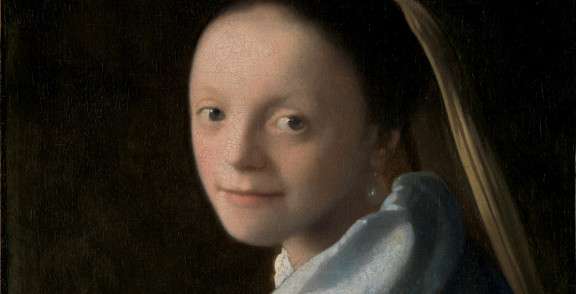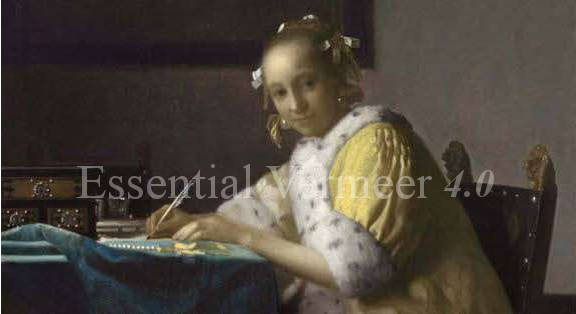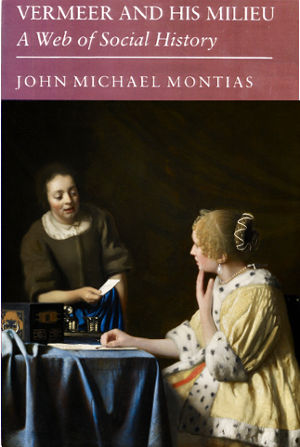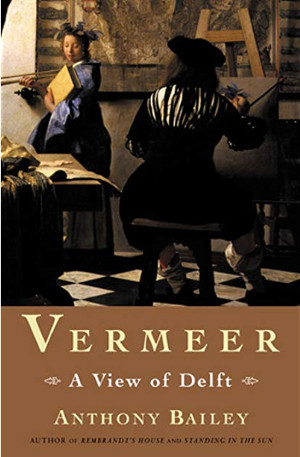A Timeline of Vermeer's Life - 1653–1660
Modern art aficionados should recognize that the art world of the twentieth century bears little resemblance to the era of Johannes Vermeer. In the seventeenth century, the concept of private art galleries, eagerly anticipated international exhibitions, critical art reviews in newspapers, and extensive art commentary was virtually non-existent. Dutch painters, largely viewing themselves as mere skilled craftsmen, rarely documented their thoughts about themselves or their work. The general Dutch populace was not acutely aware of their living amidst the 'Golden Age of Dutch Painting,' and the way art was appreciated and discussed then differs markedly from our modern perspectives.
The primary historical records concerning seventeenth-century Dutch artists, including Vermeer, are predominantly legal and transactional documents — notarial depositions, business records, and municipal clerical entries. These documents often present an individual's life from a rather adversarial viewpoint, lacking a comprehensive or balanced portrayal of their personal and professional experiences. For instance, significant life events like Vermeer's baptism, marriage, and burial are documented in the vellum-bound registers of Delft's Old and New Churches, but these only offer sparse glimpses into his life.
Regarding Vermeer's early years, the trail goes cold after his baptism in 1632 until he marries Catharina Bolnes in 1653. While subsequent archival records don't reveal much about Vermeer's personality, they do provide a clear picture of his family background and social environment.
The cornerstone of our understanding of Vermeer's life and times is John Michael Montias' seminal work, Vermeer and His Milieu: A Web of Social History. This book is a must-read for anyone intrigued by Vermeer or the artistic context of his time, as it forms the bedrock of all subsequent research on the artist. Montias embarked on an exploratory journey into the life of this enigmatic figure, unearthing surprising details: Vermeer's grandfather was a convicted counterfeiter, his grandmother ran illicit lotteries, and Vermeer himself fathered thirteen children, dying penniless at forty-three. These revelations underscore the fact that much remains to be discovered about Vermeer, a fascinating artist shrouded in mystery.
Anthony Bailey's Vermeer: A View of Delft is another vibrant addition to literature on the Dutch master, offering an accessible and engaging narrative. Bailey skillfully intertwines the life stories of Vermeer's contemporaries, including the renowned scientist Anton Van Leeuwenhoek, and delves into Vermeer's possible Catholic faith in a predominantly Protestant Netherlands. His approach of structuring the book around individual paintings adds a unique dimension, allowing readers to journey through Vermeer's life and times.
In order to ensure reasonable loading time, this timeline has been divided into five sections.
- 1632–1639
childhood - 1643–1652
adolescence - 1653–1660
early career - 1661–1667
maturity - 1668–1675
last years
1653: Vermeer's Age, 21
VERMEER'S LIFE & ART |
On October 12, Vermeer's father, Reynier Janz. Vos, is buried at the age of 61 in the Nieuwe Kerk, Delft. |
DUTCH PAINTING |
 Aristotle with a Bust of Homer Rembrandt 1653  Still Life with Drinking-Horn Willem Kalf c. 1653 Pieter de Hooch, the master of intimate interiors and courtyards scenes whose work is frequently associated with Vermeer's, arrives in Delft from Haarlem. Gaspar van Wittel (d. 1736) is born in Amersfoort. In the late 1670s he moves to Italy where he becomes famous for his finely detailed views of Rome. There he is known as "Gaspare Vanvitelli." Willem Kalf produces sumptuously rich still lifes. He is one of the most celebrated of all sill-life painters in the Netherlands. In 1642–1646 he works in Paris. On his return to the Netherlands he lives in Hoorn and then in 1653 settles in Amsterdam. His early works are modest kitchen and courtyard scenes, but he soon becomes the outstanding exponent of a type of still life in which fruit and precious objects—porcelain, oriental rugs, Venetian glass - are arranged in grand Baroque displays. His pictures are sometimes compared with those of Vermeer because of his masterly handling of texture and his ability to manipulate warm and cool colors (he frequently contrasts the reddish browns in a carpet with the yellow of a peeled lemon and the blue and white of porcelain). Jacob van Ruisdael paints Schloss Bentheim. Gerrit ter Borch paints The Dispatch. Jan van Goyen paints View of the Rhine. Simon de Vlieger, dies. Vlieger, principally a painter of marine subjects, is active in his native Rotterdam, Delft and Amsterdam. One of the outstanding marine painters of his period, he moves from stormy subjects in the manner of Porcellis to serene and majestic images that influenced van de Capelle and Willem van de Velde the Younger. De Vlieger also paints a few landscapes and genre pictures. |
EUROPEAN PAINTING & |
 S. Agnese in Agone (Rome) Francesco Borromini begun 1652 Francesco Borromini: S. Agnese in Agone, Rome. Initially Borromini works as a stone mason under Carlo Maderno, the official architect to Saint Peter's. By 1620 he is drafting and designing. When Maderno dies in 1629, Borromini joins the workshop of Bernini. Under Bernini he gains more experience as a draftsman and designer. In 1634 he begins work as an independent architect with his reconstruction of the monastery and church of Saint Carlo Borromeo. Borromini's architecture springs from the contrast between convention and freedom. Borromini uses tradition as a basis for design but did not view it as an ultimate, unalterable law. |
MUSIC |
Sept. 1, Johann Pachelbel (d.1706), German organist and composer, is born. Pachelbel writes both free works (toccatas, fantasies, fugues, etc.) and chorale settings. His development of the "cantus firmus" chorale is perhaps his greatest contribution. It consists of the chorale melody in long notes, one phrase at a time, each phrase preceded by fore-imitation in the accompanying voices. This compositional pattern influences many other composers and eventually becomes a standard form. Nov. 26, Andreas Anton Schmelzer, composer, is born. 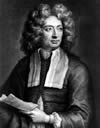 Arcangelo Corelli Arcangelo CorelliArcangelo Corelli, Italian composer, is born. Corelli exercises a wide influence on his contemporaries and on the succeeding generation of composers. It was his skill on the new instrument known as the violin and his extensive and very popular concert tours throughout Europe which does most to give that instrument its prominent place in music. It is probably correct to say that Corelli's popularity as a violinist was as great in his time as is Paganini's during the nineteenth century. |
LITERATURE |
|
SCIENCE & PHILOSOPHY |
|
| HISTORY | Feb. 2, New Amsterdam, now New York City, is incorporated. Apr. 20, Cromwell routs the English parliament. May 18, Carel Reyniersz (48), Governor-General of Netherlands and East Indies, dies. Peter Stuyvesant, governor of New Netherlands, orders a wall built to protect the Dutch settlers from the Indians. The wall gives New York's Wall Street its name. Admiral Tromp, Dutch hero, dies in a naval battle. |
1654: Vermeer's Age, 22
VERMEER'S LIFE & ART |
 Diana and Her Companions Johannes Vermeer c. 1653–1656 On January 10, Vermeer serves as witness to a notarized obligation of debt and is described as "master painter." |
DUTCH PAINTING |
 Hendrickje Bathing in a River Rembrandt 1654  Paternal Admonition Gerrit ter Borch 1654–1655 Jacob Vrel (d.1662) is born. Vrel's seemingly naïve style and his pictures' rarity even have prompted speculation that he is an amateur. Scholars most often link Vrel's manner to Delft artists such as Johannes Vermeer and Pieter de Hooch, but elements in his street scenes seem to indicate connections to Haarlem, Friesland, Flanders, or the lower Rhineland. Oct. 12, Rembrandt's most talented pupil Carel Fabritius, dies in October from wounds suffered in the explosion of the municipal powder magazine, which lays waste the northeastern side of Delft. Fabritius is at his easel painting. The gunpowder magazine, which contained about 80,000 pounds of powder, blows up "with such a horrible rush and force that the arches of heaven seemed to crack and burst." Rembrandt paints a portrait of poet-businessman Jan Six and A Woman Bathing in a Stream. After studying with Rembrandt, Nicholaes Maes returns to Dordrecht and specializes in intimate household scenes. Jacob van Loo paints An Allegory of Venus and Cupid as Lady World and Homo Bulla. Carel Fabritius paints The Goldfinch. |
EUROPEAN PAINTING & |
|
MUSIC |
Johann Amos Comenius publishes in Nuremberg first picture book for children, "Orbis sensualium pictus. |
LITERATURE |
|
| SCIENCE & PHILOSOPHY | Nov. 23, Blaise Pascal (1623–1662), scientist and philosopher, undergoes a mystical experience. He abandons his scientific work and devotes himself to philosophy and theology. His two most famous works date from this period: the Lettres provinciales and the Pensées. He enters a hermitage at Port-Royal des Champs and never again publishes in his own name. He comes up with the idea that believing in God is safer than not believing because it might gain one eternal life. He is a Jansenist, and thereby rejects free will in favor of predestination. De Circuli Magnitudine Inventa, by Dutch mathematician-astronomer-physicist Christiaan Huygens, 25, attracts widespread attention. |
| HISTORY | January 10, Russia's Czar Alexander announces a war against Lithuania and Poland. It lasts until 1667. |
1655: Vermeer's Age, 23
VERMEER'S LIFE & ART |
 Christ in the House of Martha and Mary Johannes Vermeer c. 1654–1656 On December 14, Vermeer and his wife co-sign a document, positioning themselves as secondary sureties and co-principals for a debt left by the late Reynier Jansz. Vos. The document is signed "Johannes Reijninjersz Vermeer," with "Vosch" crossed out. Vermeer signs and dates his Saint Praxedis, presumably, a copy of a work by the Italian artist, Felice Ficcherelli. During the devastating Delftse Donderslag on 12th October, 1654, Mechelen suffered damage. Vermeer's first known paintings, Christ in the House of Martha and Mary, Diana and Her Companions, and two lost works (The Visit to the Tomb and Jupiter, Venus and Mercury) belong to what was considered by art theorists of the time to be the most elevated type of subject matter, "histories." This fact testifies the young artist's artistic ambitions. Other Dutch painters, such as Pieter de Hooch, Nicolas Maes and Gerrit ter Borch had already pioneered sophisticated upper-middle class interior genre scenes that would later be revisited and revised by Vermeer. |
DUTCH PAINTING |
 The Idle Servant Nicolas Maes 1655  Woman Writing a Letter Gerrit ter Borch c. 1655 c. 1656 Jacob van Ruisdael moves to Amsterdam Rembrandt paints Woman Bathing in a Stream and Polish Rider. Pieter de Hooch, who directly influences Vermeer joins the guild of Saint Luke in Delft, two years after his arrival from Haarlem. He will remain in Delft painting his finest works until 1660. c. 1658 Miendert Hobbema becomes an apprentice in Jacob van Ruisdael's Amsterdam studio. In the exercise of his craft Hobbema was patient beyond all conception. It is doubtful whether any one ever so completely mastered as he did the still life of woods and hedges, or mills and pools. Nor can we believe that he obtained this mastery otherwise than by constantly dwelling in the same neighborhood, most likely in Guelders or on the Dutch Westphalian border, where day after day he could study the branching and foliage of trees and underwood embowering cottages and mills, under every variety of light, in every shade of transparency, in all changes produced by the seasons. |
EUROPEAN PAINTING & |
Luca Giordano develops a rich baroque vein of painting deriving in particular from Rubens. He is nicknamed "Luca Fa Presto" (Luke work quickly) because of his prodigious speed of execution and huge output. He begins to work in the circle of Ribera, but his style becomes much more colorful under the influence of such great decorative painters as Veronese, whose works he sees on his extensive travels. He absorbs a host of influences and is said to be able to imitate other artists' styles with ease. His work is also varied in subject-matter, although he is primarily a religious and mythological painter. Soon after the death of Charles in 1700, Giordano, now wealthy, returns to Naples. He spends large sums in acts of munificence, and is particularly liberal to his poorer brother artists. One of his maxims is that the good painter is the one whom the public likes, and that the public is attracted more by colour than by design. Giordano has been criticized as being a prolific painter of all styles, and master of none. He is now viewed as a proto-Tiepolo, reanimating that grand manner of Cortona in a style that would brighten with Tiepolo. c. 1655 Murillo paints genre scenes in Seville, where, from 1658 to 1660, he involved in the founding of the Academy of Art, sharing its direction, in 1660, with the architect, Francisco Herrera el Mozo. This is Murillo's period of greatest activity, and he receives numerous important commissions, among them the altar piece for the Augustinian monastery, the paintings for Santa María la Blanca (completed in 1665), and others. |
MUSIC |
Aug. 13, Johann Christoph Denner, inventor of the clarinet, is born. |
LITERATURE |
|
| SCIENCE & PHILOSOPHY | Blaise Pascal: Lettres provinciales, against Jesuits 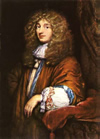 Portrait of Christiaan Huygens Caspar Netscher 1671 Mar. 25, Christiaan Huygens discoverers Titan, Saturn's largest satellite. Huygens is a great figure in the fields of research into mathematical physics, astronomy and optics, and among the founders of mechanics and optical physics. He makes astronomical observations about the planets, of the nebula of Orion and of the Moon, all reported in Systema Saturnium. Hooke publishes the Micrographia. |
| HISTORY | Pope Innocent X dies; Fabio Chigi becomes Pope Alexander VII. Apr. 26, Dutch West Indies Co. denies Peter Stuyvesant's desire to exclude Jews from New Amsterdam. Sept. 26, Peter Stuyvesant recaptures Dutch Ft. Casimir from Swedish in Delaware. French society uses a clean plate for each new dish but Englishmen continue to dine off trenchers—wooden platters that give hearty eaters the name "trenchermen." Rum from Jamaica is introduced into the Royal Navy to supplement beer, which goes sour after a few weeks at sea. |
1656: Vermeer's Age, 24
VERMEER'S LIFE & ART |
In Dec. Vermeer pays the remaining sum (1.5 guilders) of the master's fee in the Guild of Saint Luke that he was unable to pay in 1653.  The Procuress Johannes Vermeer 1656 Vermeer signs one of his first known paintings, The Procuress. The young artist seems to still be dependent on well established pictorial models and does not yet advert the influence of the newer interior genre scenes of his contemporaries. Until 1668, Vermeer does not date any other painting. Thef Caravaggesque scene of The Procuress can be found in the collections of local connoisseurs. He may even be directly inspired by The Procuress by Dirckv an Baburen which in part of his mother-in-law's art collection. Van Baburen's work will show up on the back wall of two of Vermeer's later interiors, The Concert and Lady Seated at a Virginal. The young man holding a cittern and a glass of wine in Vermeer's Procuress is considered to be a self-portrait. In The Procuress, a Chinese bowl appears on the extreme right -had side of the table. Between 1602 and 1657 the Dutch import millions of pieces of porcelain. Native Delft artisans begin feverishly producing everything from elaborate imitations of Chinese porcelain to the humble floor tiles seen in some of Vermeer's interiors. By 1656 Maria Thin, Vermeer's mother-in-law has already advanced 300 guilders, a considerable sum, to Catharina and Johannes. Vermeer pays off the remaining part of the master's fee to the Guild of Saint Luke and signs one of his earliest known works, The Procuress. One year after the Delftse Donderslag, the States of Holland pay compensation to Vermeer’s mother Digna, who runs the inn after her husband’s death and was still living there at the time of the devastating gunpowder disaster. |
DUTCH PAINTING |
 Portrait of a Woman Frans Hals 1655–1660  Vase of Flowers with Watch Willem van Aelst 1656 Rembrandt van Rijn declares bankruptcy; his possessions is put up for sale. Jan van Goyen, an immensely prolific landscape painter, dies. Gerrit van Honthorst, another successful painter, dies. |
EUROPEAN PAINTING & |
 Las Meninas Velázquez 1656 Academy of Painting in Rome founded. Bernini: Piazza of Saint Peter's, Rome Diego Velázquez paints Las Meninas, portraying the family of Philip IV |
MUSIC |
Opening of first London opera house. |
LITERATURE |
|
| SCIENCE & PHILOSOPHY | Oct. 29, Edmund Halley, astronomer (Halley's Comet), is born. Dutch mathematician Johan van Waveren Hudde, 28, anticipates the power-series for ln (1 + x) and next year will do pioneering work on the use of space coordinates. Hudde promotes Cartesian geometry and philosophy in Holland; his discoveries (they will be called "Hudde's rules") will presage the use of algorithms to solve problems of calculus (see Newton, 1666). |
| HISTORY | Jan. 8, Oldest surviving commercial newspaper is founded in Haarlem, Netherlands. Dutch forces take the Singhalese port of Colombo from the Portuguese. Dutch East India Company shares plummet on the Amsterdam Exchange and many investors are ruined. Among them is painter Rembrandt van Rijn, now 50, who is declared bankrupt and whose possessions are put up for sale. The Dutch in Ceylon make cinnamon a state monopoly but will not have complete control of the island's cinnamon until 1658. When prices fall too low, the Dutch burn great quantities of the bark, and destroy groves of clove and nutmeg trees in the Moluccas, creating artificial scarcities that will force prices up, enriching the Dutch East India Company. |
1657: Vermeer's Age, 25
VERMEER'S LIFE & ART |
 The Maid Asleep Johannes Vermeer c. 1656–1657 About this year Vermeer paints his first true genre piece, A Maid Asleep. This work is only one or two steps removed from The Procuress, a low-life brothel scene of the kind which is very popular among Dutch burgers. The artists' palette in A Maid Asleep is warm fairly somber. A rich oriental carpet delimits the foreground and creates a flat space of both paintings. However, the horizontal and vertical organization of the later painting's planimetric surface, which would become a hallmark of the artist's oeuvre, appears for the first time. In respects to his contemporaries, Vermeer tends to minimize narrative and overt didactic messages. Maria Thins, in the first draft of her testament, leaves to Vermeer's daughters jewels (wrings bracelets and gilded chains) and the significant sum of three hundred guilders to Vermeer and Catharina, Vermeer's wife. In the same testament Maria Thins wills to Vermeer's first child, Maria, two hundred guilders. The child's name is an almost certain sign of good will that existed between Vermeer and his mother-in-law. In Nov. 30 Vermeer and his wife are lent the sum of two hundred guilders from Pieter Claesz. van Ruijven, a wealthy Delft citizen and art collector who will have likely purchases in the coming years more than twenty of Vermeer's works. This money may be a kind of advance payment on the purchase of future works. Van Ruijven is now considered Vermeer's only patron although he occasionally sold works to others. Van Ruijven is almost seven years older than Vermeer and seems to have a personal relation with Vermeer that goes beyond the usual client/artist relationship. Feb. The framemaker Anthony van der Wiel, who had married Vermeer's sister Gertruy, registers at the St Luke guild as an art dealer. |
DUTCH PAINTING |
 Self-Portrait Rembrandt 1658  Young Herdsman with Cows Aelbert Cuyp 1655–1660 Frans Snyders, dies. Both Pieter de Hooch and Vermeer begin to paint the genre interiors refining a regional south Holland type, lending it a more realistic qualities of space, light and atmosphere. The Dordrecht landscape artist Aelbert Cuyp borrows warm light and hilly scenery from Italian landscape painters. |
EUROPEAN PAINTING & |
 The Flagellation of Christ Guercino 1644 Diego Velázquez paints Las Hilanderas ("The Spinners") The Corsini pays Guercino 300 ducats for the Flagellation of Christ painted in 1657. Guercino is remarkable for the extreme rapidity of his execution. He completes no fewer than 106 large altar-pieces for churches, and his other paintings amount to about 144. In 1626 he begins his frescoes in the Duomo of Piacenza. Guercino continues to paint and teach until to the time of his death in 1666, amassing a notable fortune. |
MUSIC |
|
LITERATURE |
Le Sieur Saunier writes Encyclopdie des beaux esprits, believed to be first reference book with the word "encyclopédie" in its title. |
| SCIENCE & PHILOSOPHY | A pendulum clock is designed by Christiaan Huygens and built by Solomon Coster. Universal Mathematics (Mathesis Universalis) by John Wallis amplifies the English mathematician's system of notation, applying it to algebra, arithmetic and geometry. Wallis will be credited with inventing and introducing the symbol for infinity; he demonstrates the utility of exponents, notably negative and fractional exponents. |
| HISTORY | Mar. 23, France and England form an alliance against Spain. Jun. 1, first Quakers arrive in New Amsterdam, now New York City. A 4-year Dutch-Portuguese war begins over conflicting interests in Brazil, but Johan de Witt will end the hostilities with a peace advantageous to the Dutch. Coffee advertisements at London claim that the beverage is a panacea for scurvy, gout and other ills. Public sale of tea begins at London as the East India Company undercuts Dutch prices. The Flushing Remonstrance is written to Nieuw Amsterdam's governor Peter Stuyvesant December 27 which is probably the first declaration of religious tolerance by any group of ordinary citizens in America. The first London chocolate shop opens to sell a drink known until now only to the nobility. |
1658: Vermeer's Age, 26
VERMEER'S LIFE & ART |
 Girl Reading a Letter at an Open Window Johannes Vermeer c. 1657–1659  The Little Street Johannes Vermeer c. 1657–1661 Around this time, Johannes Vermeer created one of his earliest known interior paintings, Girl Reading a Letter at an Open Window. While this subject had previously been explored by Pieter de Hooch and other artists, Vermeer distinguished his work by eliminating anecdotal elements, focusing instead on formal compositional values and the rendering of light. From the onset of his career, Vermeer showed a unique approach, not as an original inventor but as an artist who could refine existing pictorial conventions through his personal vision. He stood out among Dutch artists for his ability to infuse the moral seriousness of history painting into scenes of domestic life. During this period, the Guild of Saint Luke likely played a central role in Vermeer's public life, serving as a professional and social hub for artists. In his personal life, Vermeer seemed to gradually distance himself from his family of origin. This inference is drawn from his deviation from the common practice of naming children after their grandparents. His first two daughters, born before 1658, were named Maria and Elizabeth, after his mother-in-law and her sister, rather than his own parents. This decision suggests a shift in Vermeer's familial affiliations and personal connections during these years. |
DUTCH PAINTING |
 The Courtyard of a House in Delft Pieter de Hooch 1658 Pieter de Hooch: paints Courtyard of a House in Delft, one of his finest works. De Hooch's courtyards likely inspire Vermeer's Little Street. Frans van Mieris paints The Duet. Adriaen van de Velde paints Farm with a Dead Tree. |
EUROPEAN PAINTING & |
Bernini: church at Castel Gandolfo (1661). Bernini does not build many churches from scratch, preferring instead to concentrate on the embellishment of pre-existing structures. He fulfills three commissions in the field; his stature allows him the freedom to design the structure and decorate the interiors in coherent designs. |
MUSIC |
Apr. 22, Giuseppe Torelli, composer (Concert Grossi op 8), is born in Italy. |
LITERATURE |
Molière is anointed with the patronage of King Louis XIV and leaves behind a body of work which not only changed the face of French classical comedy, but will go on to influence the work of other dramatists the world over. The greatest of his plays include The School for Husbands (1661), The School for Wives (1662), The Misanthrope (1666), The Doctor in Spite of Himself (1666), Tartuffe (1664, 1667, 1669), The Miser (1668), and The Imaginary Invalid (1673). |
SCIENCE & PHILOSOPHY |
Amsterdam naturalist Jan Swammerdam, 21, gives the first description of red blood cells. He will complete his medical studies in 1667 but devote himself to studying insects (see science, 1669), tadpoles, frogs and mammals rather than practicing medicine. |
HISTORY |
Sept. 3, Oliver Cromwell, Lord Protector of the New Commonwealth, i.e. ruler over England's Puritan parliament (1653–1658), dies at age 59. Richard Cromwell succeeds his father as English Lord Protector. |
1659: Vermeer's Age, 27
VERMEER'S LIFE & ART |
 Officer and Laughing Girl Johannes Vermeer c. 1657–1660  The Milkmaid Johannes Vermeer c. 1657–1661 Around 1659 or 1660, Johannes Vermeer's temperamental brother-in-law, Willem Bolnes, left his father's home in Gouda to reside on one of the family's properties in Schoonhoven. During this time, Willem accumulated debts and relied financially on his mother, Maria Thins, as his father was too impoverished to assist. Willem appeared to be unemployed and would later become a source of trouble for Vermeer and his wife. In the late 1650s, Vermeer created two notably luminous interior scenes, drawing inspiration from the genre styles prevalent at the time. In both Officer and Laughing Girl and The Milkmaid, he employed what is often referred to as his "pointillist" technique, characterized by the application of thick dots of brightly colored paint in the composition's most intensely lit areas, known as pointillés. This method enhanced the sense of radiance in these works, a quality not as prominently featured in his other paintings. Interestingly, after these works, Vermeer never again depicted members of the lower working class in his art, indicating a shift in his thematic focus. |
DUTCH PAINTING |
 Man and Woman Sitting at the Virginal Gabriel Metsu 1658–1660 Jan van der Weff (d. 1772) is born. Johan Willem, Elector Palatine, whom he had met in 1696, appoints him Court Painter in 1697 at a salary of 4,000 guilders on condition he work for him six months of the year. In 1703 this term is increased to nine months, and he is made a knight. He remains in Rotterdam, making trips to Düsseldorf to deliver pictures and paint portraits. Jan Janz de Heem (d. 1695) is born. Son of the celebrated still life painter Jan Davidsz de Heem he is baptized on 2 July I650 in Antwerp. From 1667 to 1672 he works in Utrecht with his father who sometimes retouches the son's work. There has been much confusion between the work of father and son. Jan Jansz is last recorded in a document of 1695. |
EUROPEAN PAINTING & |
1659–1661 Michael Sweerts, Flemish painter, created his rosy "Portrait of a Youth." |
MUSIC |
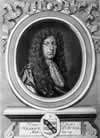 Portrait of Purcell |
LITERATURE |
Oedipus is written by Pierre Corneille at the Hôtel de Bourgogne, Paris |
| SCIENCE & PHILOSOPHY | Christiaan Huygens of Holland uses a 2-inch telescope lens and discovers that the Martian day is nearly the same as an Earth day. He also discovers the rings of Saturn and is able to construct a chronometer for use at sea; however, it is influenced by the motion of the ship and does not keep correct time. English physician Thomas Willis, 38, gives the first description of typhoid fever. Elementa curvarum, written by Jan De Witt (b. Holland, January 1625, d. 1672) gives an algebraic treatment of conic sections using the newly developed analytic geometry. It appears as part of an edition of Schooten's Geometria a Renato Des Cartes. |
HISTORY |
The Spanish infanta Marie Thérèse introduces the French court to cocoa, which will be endorsed by the Paris faculty of medicine and received with enthusiasm until it becomes surrounded with suspicion as an aphrodisiac in some circles and as a mysterious potion in others. |
1660: Vermeer's Age, 28
VERMEER'S LIFE & ART |
 The Glass of Wine Johannes Vermeer c. 1658–1661  The Girl with a Glass of Wine Johannes Vermeer c. 1659–1662 Vermeer turns to a new and more complex type of composition in the late 1650s or early 1660s in which he explore the amorous relation between educated men and women. The box-like, three-dimensional effect of these pictures is fruit of the artist's interest in perspective as an expressive means. The study and practice of perspective is held in high esteem throughout Europe. On December 27, "A child of Johannes Vermeer [living] on the Oude Langedijck" is buried in the Old Church (Oude Kerk), in Delft. This is the earliest evidence that Vermeer and his family were residing in Maria Thins' home in the Papists' corner of the city. The same document states that at the same time, Vermeer and his wife are living in the house of Maria Thins on the Oude Langendijk in Delft. At the time, the household includes Vermeer, his wife, his mother-in-law, and three children, not counting an infant who had died and at least one female servant. The house has a basement, a lower hall with a vestibule, a great hall, a small room adjoining the hall, an interior kitchen, a little back kitchen, a cooking kitchen, a washing kitchen, a corridor, and an upper floor with two rooms, one of which is taken up by Vermeer's studio. Vermeer's family situation is unusual. Very few married men in the Netherlands live with a parent or parent-in-law for an extended period of time. Vermeer's marriage too, must be considered exceptional in as much as he marries outside his own family's religion and social class. He moves from the lower, artisanal class of his Reformed parents who lived on the Delft Square to the higher social stratum of the Catholic in-laws who instead live in the so-called "Papist Corner," the Catholic quarter of the city. The burial record of his child is the earliest known notice of the artist's residence in Maria Thin's house. |
DUTCH PAINTING |
Jan van Mieris (d.1690) is born. Son of the famous Frans van Mieris, Jan paints principally history subjects, but his earliest works were apparently genre scenes in his father's manner.  The Jewish Cemetery Jacob van Ruisdael 1660 Jacob van Ruisdael paints Jewish Cemetery. The painting's ruinous scene exemplifies the trend toward turbulence in Dutch landscape at mid-seventeenth century. Adriean Coorte (d. 1707) is born. Coorte devotes himself to the rendering of simple objects in small paintings. His paintings often have strong illumination that gives the composition an enchanting stillness, which contributes to Coorte's appeal. |
EUROPEAN PAINTING & |
Diego Velázquez, Spanish painter, dies. |
MUSIC |
Alessandro Scarlatti (d. 1725), Italian musician and composer, father of Domenico, is born. |
LITERATURE |
Molière writes Don Juan. |
| SCIENCE & PHILOSOPHY | Marcello Malpighi discovers that the lungs consist of many small air pockets and a complex system of blood vessels. By observing capillaries through a microscope he completes the work of Harvey in describing the circulation of the blood. Robert Boyle announces in New Experiments Physico-Mechanical Touching the Spring of Air that removing the air in a vacuum chamber extinguishes a flame and kills small animals, indicating that combustion and respiration are similar processes. |
| HISTORY | May 28, George I, king of England (1714–1727), is born. In the 1660s, the British began to dominate the trade in port wine from Portugal after a political spat with the French who deny them their wines from Bordeaux. Brandy is added to the Portuguese wines to fortify them for the Atlantic voyage. |
